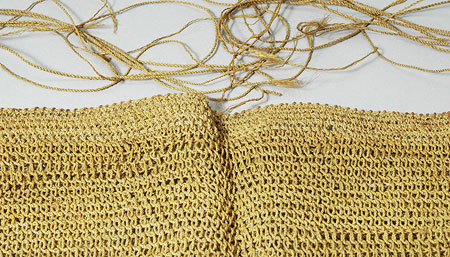Accession Number:
1940.7.090
Country:
Sudan
Region:
[Southern Sudan] [Al Istiwa'iyah] [Equatoria] Eastern Equatoria Logwi
Cultural Group:
[Imatong]
Date Made:
By 1940
Materials:
Grass Fibre Plant , String
Process:
Looped , Openwork Woven , Netted
Dimensions:
Total length ties and apron width = 1600; apron L = 365, W = 410, th = 7; w apron band = 28, diam string = 1.5 mm [RTS 8/3/2005].
Weight:
178.3
Other Owners:
Samuel P. Powell
Field Collector:
Samuel P. Powell
PRM Source:
Samuel P. Powell
Acquired:
Loaned July 1940
Collected Date:
By 1940
Description:
Open-work apron made from twisted yellowish brown grass fibre string (Pantone 7508C), with each length made from two strands twisted together.
The upper part of the apron consists of a broad band of single thickness, in which there are pairs of horizontal strings running across the pattern, one left free and the other woven in with vertical elements composed of a series of interlocking loops.
The horizontal strings extend beyond the finished edges of this band as 10 cords that could be used as waist ties.
These are fraying along their lengths and at their ends.
Several of these have taken on a pinkish red colouring from contact with ochre.
Below this waist band, the body of the apron is made of these interlocking loops only; this has been woven as a continuous cylinder of netting, with the top edges looped into the waist band on both sides to create a double thickness of netting, without any seams.
At its base, the open edges were then sewn together by overstitching with another length of twisted fibre, and finished with a knot at one side.
Occasional knots are also visible across the surface where separate lengths of fibre were joined together.
The apron could probably be worn with either side facing outwards, and occasional ochre stains across both sides suggest this had been the case.
The object is complete, but has been mended; there is also a crease running down the centre of the garment where it has been folded.
It has a weight of 178.3 grams.
The apron body is 365 mm long, 410 mm wide and 7 mm thick; the waistband is 28 mm wide; the bundle of string ties have a total length of 1600 mm, stretched out, and the grass string has a diameter of 1.5 mm.
Collected by Samuel P. Powell from Logwi, in the modern administrative district of Eastern Equatoria, and loaned to the Pitt Rivers Museum in 1940. It came from the 'Imatong tribe', who are presumably a group located somewhere around Jebel Imatong, a mountain peak in Southeastern Sudan, south of Torit. This type of apron was worn by girls, and sometimes also by married women when working in the fields.
Rachael Sparks 14/9/2005.
Collected by Samuel P. Powell from Logwi, in the modern administrative district of Eastern Equatoria, and loaned to the Pitt Rivers Museum in 1940. It came from the 'Imatong tribe', who are presumably a group located somewhere around Jebel Imatong, a mountain peak in Southeastern Sudan, south of Torit. This type of apron was worn by girls, and sometimes also by married women when working in the fields.
Rachael Sparks 14/9/2005.
Primary Documentation:
Accession Book Entry
[Loans II, p.
308] - ESTATE OF S.P.
POWELL, C/O N.H.
HASLAM, Esq.
Manager, Westminster Bank, Stony Stratford, Bucks.
Collected by himself.
Data from his labels and notes.
[p.
313] From the IMATONG TRIBE.
EQUATORIAL PROVINCE, ANGLO-EGYPTIAN SUDAN.
[p.
314] 1940.7.090 - Girl's net apron.
Sometimes worn also be married women when working in the fields.
From LOGWI.
E[QUATORIAL].P[ROVINCE].
Related Documents File - Appears on undated typed list: "Imatong girls net apron. This is sometimes worn by the married women when working in the fields". List is annotated by hand on back: "List of Curios" and "Far from complete" [RTS 16/12/2003].
Pitt Rivers Museum label - Girl's net apron. Also used by older women when working in the fields. IMATONG. Logwi, E[quatorial]. P[rovince]. S.P. Powell [brown luggage tag, tied to object; had been marked 1940.7.091 incorrectly; this was corrected, RTS 8/3/2005].
Related Documents File - Appears on undated typed list: "Imatong girls net apron. This is sometimes worn by the married women when working in the fields". List is annotated by hand on back: "List of Curios" and "Far from complete" [RTS 16/12/2003].
Pitt Rivers Museum label - Girl's net apron. Also used by older women when working in the fields. IMATONG. Logwi, E[quatorial]. P[rovince]. S.P. Powell [brown luggage tag, tied to object; had been marked 1940.7.091 incorrectly; this was corrected, RTS 8/3/2005].



